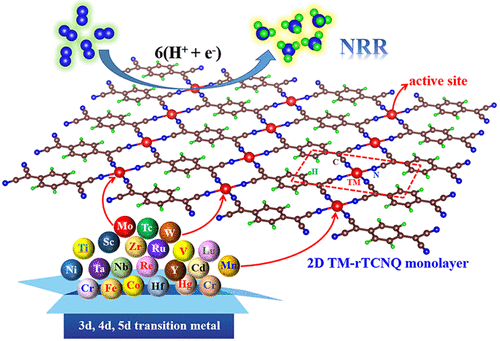当前位置:
X-MOL 学术
›
ACS Appl. Mater. Interfaces
›
论文详情
Our official English website, www.x-mol.net, welcomes your
feedback! (Note: you will need to create a separate account there.)
Electrocatalytic Mechanism of N2 Reduction Reaction by Single-Atom Catalyst Rectangular TM-TCNQ Monolayers
ACS Applied Materials & Interfaces ( IF 8.3 ) Pub Date : 2021-06-18 , DOI: 10.1021/acsami.1c06368 Sheng-Yao Lv 1, 2 , Chun-Xiang Huang 1, 2 , Guoliang Li 1 , Li-Ming Yang 2
ACS Applied Materials & Interfaces ( IF 8.3 ) Pub Date : 2021-06-18 , DOI: 10.1021/acsami.1c06368 Sheng-Yao Lv 1, 2 , Chun-Xiang Huang 1, 2 , Guoliang Li 1 , Li-Ming Yang 2
Affiliation

|
Herein, the catalytic properties and reaction mechanisms of the 3d, 4d, and 5d transition metals embedded in 2D rectangular tetracyanoquinodimethane (TM-rTCNQ) monolayers as single-atom catalysts (SACs) for the electrocatalytic N2 reduction reaction (NRR) were systematically investigated, using first-principles calculations. A series of high-throughput screenings were carried out on 30 TM-rTCNQ monolayers, and all possible NRR pathways were explored. Three TM-rTCNQ (TM = Mo, Tc, and W) SACs were selected as promising new NRR catalyst candidates because of their high structural stability and good catalytic performance (low onset potential and high selectivity). Our results show that the Mo-rTCNQ monolayer can catalyze NRR through a distal mechanism with an onset potential of −0.48 V. Surprisingly, the NH3 desorption energy on the Mo-rTCNQ monolayer is only 0.29 eV, the lowest one reported in the literature so far, which makes the Mo-rTCNQ monolayer a good NRR catalyst candidate. In-depth research studies on the structures of N2–TM-rTCNQ (TM = Mo, Tc, and W) found that strong adsorption and activation performance of TM-rTCNQ for N2 may be due to the strong charge transfer and orbital hybridization between the TM-rTCNQ catalyst and the N2 molecules. Our work provides new ideas for achieving N2 fixation under environmental conditions.
中文翻译:

单原子催化剂矩形TM-TCNQ单层对N 2还原反应的电催化机理
在此,系统研究了嵌入二维矩形四氰基醌二甲烷 (TM-rTCNQ) 单层中的 3d、4d 和 5d 过渡金属作为单原子催化剂 (SAC) 用于电催化 N 2还原反应 (NRR)的催化性能和反应机制,使用第一性原理计算。对 30 个 TM-rTCNQ 单层进行了一系列高通量筛选,并探索了所有可能的 NRR 途径。三种 TM-rTCNQ(TM = Mo、Tc 和 W)SAC 被选为有前景的新型 NRR 催化剂候选者,因为它们具有高结构稳定性和良好的催化性能(低起始电位和高选择性)。我们的结果表明,Mo-rTCNQ 单层可以通过起始电位为 -0.48 V 的远端机制催化 NRR。令人惊讶的是,NH3 Mo-rTCNQ 单层的解吸能仅为 0.29 eV,是迄今为止文献报道的最低值,这使得 Mo-rTCNQ 单层成为一种很好的 NRR 催化剂候选者。对N 2 –TM-rTCNQ(TM = Mo、Tc和W)结构的深入研究发现TM-rTCNQ对N 2 的强吸附和活化性能可能是由于强电荷转移和轨道杂化在 TM-rTCNQ 催化剂和 N 2分子之间。我们的工作为在环境条件下实现 N 2固定提供了新思路。
更新日期:2021-06-30
中文翻译:

单原子催化剂矩形TM-TCNQ单层对N 2还原反应的电催化机理
在此,系统研究了嵌入二维矩形四氰基醌二甲烷 (TM-rTCNQ) 单层中的 3d、4d 和 5d 过渡金属作为单原子催化剂 (SAC) 用于电催化 N 2还原反应 (NRR)的催化性能和反应机制,使用第一性原理计算。对 30 个 TM-rTCNQ 单层进行了一系列高通量筛选,并探索了所有可能的 NRR 途径。三种 TM-rTCNQ(TM = Mo、Tc 和 W)SAC 被选为有前景的新型 NRR 催化剂候选者,因为它们具有高结构稳定性和良好的催化性能(低起始电位和高选择性)。我们的结果表明,Mo-rTCNQ 单层可以通过起始电位为 -0.48 V 的远端机制催化 NRR。令人惊讶的是,NH3 Mo-rTCNQ 单层的解吸能仅为 0.29 eV,是迄今为止文献报道的最低值,这使得 Mo-rTCNQ 单层成为一种很好的 NRR 催化剂候选者。对N 2 –TM-rTCNQ(TM = Mo、Tc和W)结构的深入研究发现TM-rTCNQ对N 2 的强吸附和活化性能可能是由于强电荷转移和轨道杂化在 TM-rTCNQ 催化剂和 N 2分子之间。我们的工作为在环境条件下实现 N 2固定提供了新思路。


















































 京公网安备 11010802027423号
京公网安备 11010802027423号